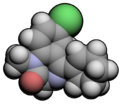Tetrazepam
Tetrazepam is a benzodiazepine derivative with anxiolytic, anticonvulsant, muscle relaxant and slightly hypnotic properties. It was patented in 1962 by Hoffmann-La Roche, a Swiss multinational healthcare company, and has been in medical use since 1965. Tetrazepam is used primarily in the treatment of severe muscle spasms, including those associated with conditions such as tetanus or cerebral palsy.
Pharmacology[edit]
Tetrazepam, like other benzodiazepines, works by enhancing the effect of the neurotransmitter gamma-aminobutyric acid (GABA) in the brain, leading to sedative and muscle-relaxant effects. It is metabolized in the body to diazepam, oxazepam, and temazepam, all of which have similar pharmacological effects.
Medical uses[edit]
Tetrazepam is used for the treatment of stiff-man syndrome, muscle cramps, and spasticity. It is also used in the treatment of some types of epilepsy and insomnia. In addition, it is used as a premedication before surgical procedures to reduce anxiety and tension.
Side effects[edit]
The most common side effects of tetrazepam are drowsiness, fatigue, and muscle weakness. Less common side effects include confusion, depression, and changes in libido. As with other benzodiazepines, there is a risk of dependence and withdrawal symptoms with prolonged use.
Legal status[edit]
Tetrazepam is a controlled substance in many countries, including the United States, where it is classified as a Schedule IV controlled substance under the Controlled Substances Act. In the European Union, it was withdrawn from the market in 2013 due to concerns about serious skin reactions.
See also[edit]
-
Tetrazepam chemical structure
-
3D model of Tetrazepam
-
Epikutanni test
Ad. Transform your life with W8MD's Budget GLP-1 injections from $75


W8MD offers a medical weight loss program to lose weight in Philadelphia. Our physician-supervised medical weight loss provides:
- Weight loss injections in NYC (generic and brand names):
- Zepbound / Mounjaro, Wegovy / Ozempic, Saxenda
- Most insurances accepted or discounted self-pay rates. We will obtain insurance prior authorizations if needed.
- Generic GLP1 weight loss injections from $75 for the starting dose.
- Also offer prescription weight loss medications including Phentermine, Qsymia, Diethylpropion, Contrave etc.
NYC weight loss doctor appointmentsNYC weight loss doctor appointments
Start your NYC weight loss journey today at our NYC medical weight loss and Philadelphia medical weight loss clinics.
- Call 718-946-5500 to lose weight in NYC or for medical weight loss in Philadelphia 215-676-2334.
- Tags:NYC medical weight loss, Philadelphia lose weight Zepbound NYC, Budget GLP1 weight loss injections, Wegovy Philadelphia, Wegovy NYC, Philadelphia medical weight loss, Brookly weight loss and Wegovy NYC
|
WikiMD's Wellness Encyclopedia |
| Let Food Be Thy Medicine Medicine Thy Food - Hippocrates |
Medical Disclaimer: WikiMD is not a substitute for professional medical advice. The information on WikiMD is provided as an information resource only, may be incorrect, outdated or misleading, and is not to be used or relied on for any diagnostic or treatment purposes. Please consult your health care provider before making any healthcare decisions or for guidance about a specific medical condition. WikiMD expressly disclaims responsibility, and shall have no liability, for any damages, loss, injury, or liability whatsoever suffered as a result of your reliance on the information contained in this site. By visiting this site you agree to the foregoing terms and conditions, which may from time to time be changed or supplemented by WikiMD. If you do not agree to the foregoing terms and conditions, you should not enter or use this site. See full disclaimer.
Credits:Most images are courtesy of Wikimedia commons, and templates, categories Wikipedia, licensed under CC BY SA or similar.
Translate this page: - East Asian
中文,
日本,
한국어,
South Asian
हिन्दी,
தமிழ்,
తెలుగు,
Urdu,
ಕನ್ನಡ,
Southeast Asian
Indonesian,
Vietnamese,
Thai,
မြန်မာဘာသာ,
বাংলা
European
español,
Deutsch,
français,
Greek,
português do Brasil,
polski,
română,
русский,
Nederlands,
norsk,
svenska,
suomi,
Italian
Middle Eastern & African
عربى,
Turkish,
Persian,
Hebrew,
Afrikaans,
isiZulu,
Kiswahili,
Other
Bulgarian,
Hungarian,
Czech,
Swedish,
മലയാളം,
मराठी,
ਪੰਜਾਬੀ,
ગુજરાતી,
Portuguese,
Ukrainian



